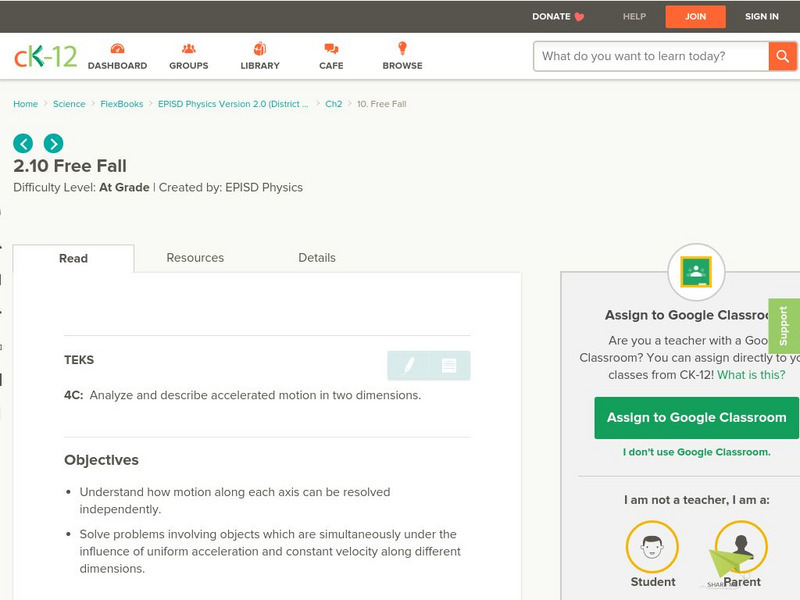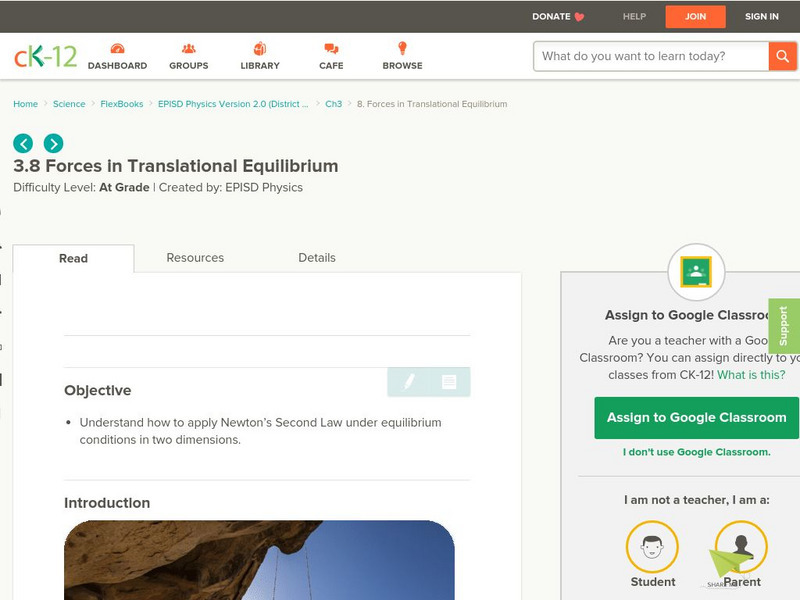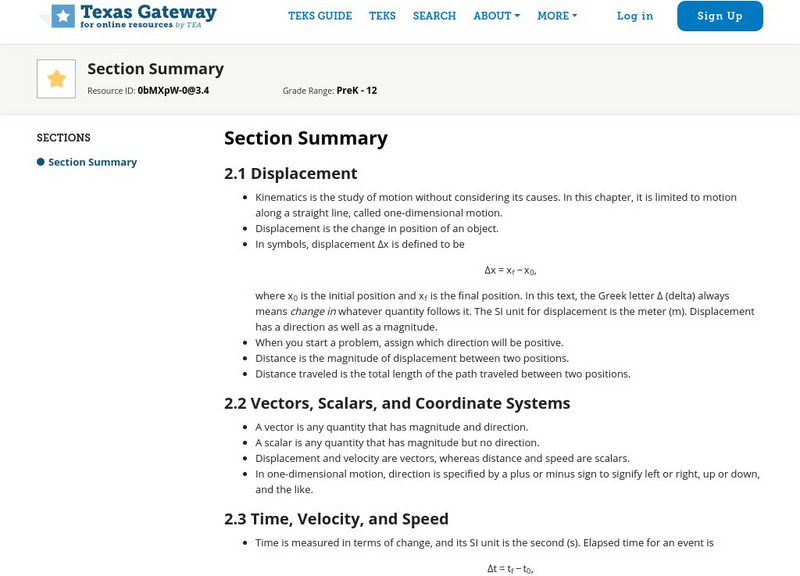Physics Classroom
The Physics Classroom: Vectors and 2 D Motion Table of Contents
Learners explore vectors, projectile motion, and forces in two-dimension. The tutorial consists of lessons and problems to check for understanding.
American Association of Physics Teachers
Com Padre Digital Library: Open Source Physics: Remarkable Three Body Motions
What happens in space when a third celestial body joins two others? Discover both simple and complex situations which occur supporting Newtonian law in space with this collection of applets.
Physics Classroom
The Physics Classroom: Vectors: Double Trouble in 2 Dimensions
In this interactive tutorial, analyze two-body problems in which the objects are moving in different directions.
CK-12 Foundation
Ck 12: Episd: Free Fall
[Free Registration/Login may be required to access all resource tools.] Use this opportunity to understand accelerated motion in two dimensions, free fall.
CK-12 Foundation
Ck 12: Forces in Translational Equilibrium
[Free Registration/Login may be required to access all resource tools.] The following tutorial helps students to understand how to apply Newton's Second Law under equilibrium conditions in two dimensions.
Texas Education Agency
Texas Gateway: Rotational Motion and Angular Momentum: Conceptual Questions
This page provides 30 questions that cover the major concepts presented in Chapter 10: Rotational Motion and Angular Momentum from the AP Physics online text.
Physics Classroom
The Physics Classroom: 1 D Kinematics: Motion of a Two Stage Rocket
Observe the motion of the two-stage rocket and the corresponding, animated velocity-time graph in these illustrations.
Texas Education Agency
Texas Gateway: Rotational Motion and Angular Momentum: Summary
This page provides a summary of each section in Chapter 10: Rotational Motion and Angular Momentum from the AP Physics online text.
CK-12 Foundation
Ck 12 Exploration Series: Simulations: Physics: Portrait Gallery
[Free Registration/Login Required] Learn about adding force vectors in two dimensions using the example of a painting hanging from two strings. Experiment with variables of weight and angles to hang a portrait in this physics simulation....
University of Virginia
Uva Physics: Using Vectors to Describe Motion
Background information on vectors and their use in describing motion in two dimensions. A comparison of Aristotle's and Galileo's perspectives on force and motion is given.
CK-12 Foundation
Ck 12 Exploration Series: Simulations: Physics: Horse and Cart
[Free Registration/Login Required] Learn about Newton's third law of motion, calculations in two dimensions, and the interaction of multiple objects in the context of a horse pulling a cart.
Physics Classroom
The Physics Classroom: Horizontally Launched Projectile Problems
In the case of projectiles, students use information about the initial velocity and position of a projectile to predict such things as how much time the projectile is in the air and how far the projectile will go. They do this to make...
University of Texas at Austin
The University of Texas Mc Donald Observatory: Shadow Play
Everyone and everything has a shadow. Shadows illustrate how three-dimensional objects can be viewed in two dimensions.
Physics Classroom
The Physics Classroom: Vectors: Non Horizontally Launched Projectile Problems
In this physics tutorial on vectors, the use of kinematic equations to solve non-horizontally launched projectiles is demonstrated.
Open Curriculum
Open Curriculum: Conservation of Angular Momentum
Students learn the concept of angular momentum of objects in two dimensions and how rotational motion is determined.
CK-12 Foundation
Ck 12: Episd: Speed
[Free Registration/Login may be required to access all resource tools.] Understand what speed is and how to calculate it in one dimension motion.
Texas Education Agency
Texas Gateway: Kinematics Section Summary
This is a summary of the main topics for AP Physics Chapter 2 Kinematics. These include Displacement; Vectors, Scalars, and Coordinate Systems; Time, Velocity, and Speed; Acceleration; Motion Equations for Constant Acceleration in One...
American Museum of Natural History
American Museum of Natural History: O Logy: It's All Relative
Learn about the 4th dimensions and the theory of relativity.There is no absolute, or "same," time and space. This means time and space are different for everyone! How you experience events in time and space depends on two important...












